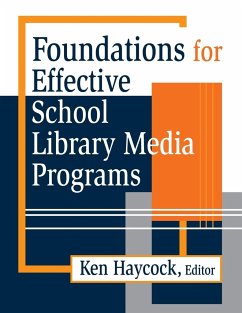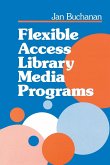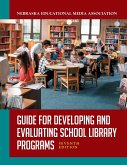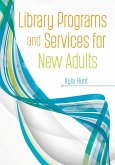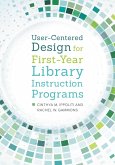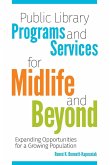Ken Haycock
Foundations for Effective School Library Media Programs
Ken Haycock
Foundations for Effective School Library Media Programs
- Broschiertes Buch
- Merkliste
- Auf die Merkliste
- Bewerten Bewerten
- Teilen
- Produkt teilen
- Produkterinnerung
- Produkterinnerung
How can you make your school library media program more successful? This timely book identifies current trends and thinking about library media specialists as change agents and their roles in school improvement, curriculum design, collaboration with teachers, and building information literacy. Reprinted from recent issues of Emergency Librarian, 39 enlightening and exciting articles offer stimulating discussions on learning theories, flexible scheduling, new technologies, thematic units, new partnerships, and more. Articles are organized into seven sections: foundations, the school context,…mehr
Andere Kunden interessierten sich auch für
![Student Success and Library Media Programs Student Success and Library Media Programs]() Lesley FarmerStudent Success and Library Media Programs54,99 €
Lesley FarmerStudent Success and Library Media Programs54,99 €![Flexible Access Library Media Programs Flexible Access Library Media Programs]() Jan BuchananFlexible Access Library Media Programs37,99 €
Jan BuchananFlexible Access Library Media Programs37,99 €![Guide for Developing and Evaluating School Library Programs Guide for Developing and Evaluating School Library Programs]() Nebraska Educ Media AssocGuide for Developing and Evaluating School Library Programs48,99 €
Nebraska Educ Media AssocGuide for Developing and Evaluating School Library Programs48,99 €![Library Programs and Services for New Adults Library Programs and Services for New Adults]() Kyla HuntLibrary Programs and Services for New Adults47,99 €
Kyla HuntLibrary Programs and Services for New Adults47,99 €![User-Centered Design for First-Year Library Instruction Programs User-Centered Design for First-Year Library Instruction Programs]() Cinthya IppolitiUser-Centered Design for First-Year Library Instruction Programs61,99 €
Cinthya IppolitiUser-Centered Design for First-Year Library Instruction Programs61,99 €![Public Library Programs and Services for Midlife and Beyond Public Library Programs and Services for Midlife and Beyond]() Renee Bennett-KapusniakPublic Library Programs and Services for Midlife and Beyond62,99 €
Renee Bennett-KapusniakPublic Library Programs and Services for Midlife and Beyond62,99 €![Crash Course in Library Gift Programs Crash Course in Library Gift Programs]() Ann RobertsCrash Course in Library Gift Programs48,99 €
Ann RobertsCrash Course in Library Gift Programs48,99 €-
-
-
How can you make your school library media program more successful? This timely book identifies current trends and thinking about library media specialists as change agents and their roles in school improvement, curriculum design, collaboration with teachers, and building information literacy. Reprinted from recent issues of Emergency Librarian, 39 enlightening and exciting articles offer stimulating discussions on learning theories, flexible scheduling, new technologies, thematic units, new partnerships, and more. Articles are organized into seven sections: foundations, the school context, role clarification, information literacy, collaborative planning and teaching, program development, and accountability. Essential professional reading, this book can also be used as a school media textbook in library schools.
Produktdetails
- Produktdetails
- Verlag: Libraries Unlimited
- Seitenzahl: 346
- Erscheinungstermin: 15. April 1999
- Englisch
- Abmessung: 280mm x 216mm x 19mm
- Gewicht: 872g
- ISBN-13: 9781563083686
- ISBN-10: 156308368X
- Artikelnr.: 21429466
- Herstellerkennzeichnung
- Libri GmbH
- Europaallee 1
- 36244 Bad Hersfeld
- gpsr@libri.de
- Verlag: Libraries Unlimited
- Seitenzahl: 346
- Erscheinungstermin: 15. April 1999
- Englisch
- Abmessung: 280mm x 216mm x 19mm
- Gewicht: 872g
- ISBN-13: 9781563083686
- ISBN-10: 156308368X
- Artikelnr.: 21429466
- Herstellerkennzeichnung
- Libri GmbH
- Europaallee 1
- 36244 Bad Hersfeld
- gpsr@libri.de
Ken Haycock, EdD, is research professor of management and organization at the University of Southern California, where he directs the Center for Library Leadership and Management.
Contributors
Introduction
Part One: The Foundations
Chapter 1: Strengthening the Foundations for Teacher-Librarianship
Chapter 2: Research in Teacher-Librarianship and the Institutionalization
of Change
Part Two: The School Context
Chapter 3: Leadership for School Improvement
Chapter 4: The School Library Program and the Culture of the School
Chapter 5: Libraries, Learning and the Whole School
Part Three: Role Clarification
Chapter 6: The School Librarian as a Professional Teacher
Chapter 7: Navigating the '90's - The Teacher-Librarian as Change Agent
Chapter 8: Developing Information Literacy Through the Information
Intermediary Process
Chapter 9: Teacher-Librarians: Mirror Images and the Spark
Chapter 10: Students' Information Literacy Needs: Competencies for
Teacher-Librarians in the Twenty-First Century
Part Four: Informaton Literacy
Chapter 11: Information Literacy in an Information Society
Chapter 12: Media Literacy: The New Basic-Will the Real Curriculum Please
Stand Up?
Chapter 13: Student Access to the Internet: Librarians and Teachers Working
Together to Teach Higher Level Survival Skills
Chapter 14: Misinformation on the Internet: Applying Evaluation Skills to
Online Information
Chapter 15: Information Skills in the Curriculum: Developing a School-Based
Curriculum
Chapter 16: Developing a School-Based Research Strategy K-7
Chapter 17: Computer Literacy and Information Literacy: A Natural
Combination
Chapter 18: All That Glitters May Not Be Gold
Part Five: Collaborative Planning and Teaching
Chapter 19: Curriculum Encounters of the Third Kind: Teachers and
Teacher-Librarians Exploring Curriculum Potential
Chapter 20: The School Librarian and the Classroom Teacher: Partners in
Curriculum Planning
Chapter 21: Changing Teaching Practice to Meet Current Expectations:
Implications for Teacher-Librarians
Chapter 22: Expanding the Collaborative Planning Model
Chapter 23: Collaborative Planning: A Model That Works
Part Six: Program Development: A Systemic Approach
Chapter 24: Developing the School Resource Center Program: A Developmental
Approach
Chapter 25: From Library Program to Learning Resources Program: Cooperative
Program Planning and Teaching
Chapter 26: Prerequisites to Flexible Scheduling
Chapter 27: Secondary School Assignments: Cooperatively Planned and Taught
Chapter 28: A Stations Approach to Learning: The Conversation of a
Secondary School Skeptic
Chapter 29: Connecting Writing and Research Through the I-Search Paper: A
Teaching Partnership Between the Library Program and Classroom
Chapter 30: Designing Thematic Literature Units
Chapter 31: What Do You Believe About How Culturally Diverse Students
Learn?
Chapter 32: Principals and Teacher-Librarians: A Study and a Plan for
Partnership
Chapter 33: Communication Skills and Strategies for Teacher-Librarians
Part Seven: Accountability
Chapter 34: School Libraries - Definitely Worth Their Keep
Chapter 35: Using Evaluation to Bring School Library Resrouce Center
Programs into Closer Alliance with Information Power
Chapter 36: Evaluation: The Key to Growth
Chapter 37: Evaluation of the Teacher-Librarian: A Discussion Guide
Chapter 38: Theory - Where is My Reality?
Introduction
Part One: The Foundations
Chapter 1: Strengthening the Foundations for Teacher-Librarianship
Chapter 2: Research in Teacher-Librarianship and the Institutionalization
of Change
Part Two: The School Context
Chapter 3: Leadership for School Improvement
Chapter 4: The School Library Program and the Culture of the School
Chapter 5: Libraries, Learning and the Whole School
Part Three: Role Clarification
Chapter 6: The School Librarian as a Professional Teacher
Chapter 7: Navigating the '90's - The Teacher-Librarian as Change Agent
Chapter 8: Developing Information Literacy Through the Information
Intermediary Process
Chapter 9: Teacher-Librarians: Mirror Images and the Spark
Chapter 10: Students' Information Literacy Needs: Competencies for
Teacher-Librarians in the Twenty-First Century
Part Four: Informaton Literacy
Chapter 11: Information Literacy in an Information Society
Chapter 12: Media Literacy: The New Basic-Will the Real Curriculum Please
Stand Up?
Chapter 13: Student Access to the Internet: Librarians and Teachers Working
Together to Teach Higher Level Survival Skills
Chapter 14: Misinformation on the Internet: Applying Evaluation Skills to
Online Information
Chapter 15: Information Skills in the Curriculum: Developing a School-Based
Curriculum
Chapter 16: Developing a School-Based Research Strategy K-7
Chapter 17: Computer Literacy and Information Literacy: A Natural
Combination
Chapter 18: All That Glitters May Not Be Gold
Part Five: Collaborative Planning and Teaching
Chapter 19: Curriculum Encounters of the Third Kind: Teachers and
Teacher-Librarians Exploring Curriculum Potential
Chapter 20: The School Librarian and the Classroom Teacher: Partners in
Curriculum Planning
Chapter 21: Changing Teaching Practice to Meet Current Expectations:
Implications for Teacher-Librarians
Chapter 22: Expanding the Collaborative Planning Model
Chapter 23: Collaborative Planning: A Model That Works
Part Six: Program Development: A Systemic Approach
Chapter 24: Developing the School Resource Center Program: A Developmental
Approach
Chapter 25: From Library Program to Learning Resources Program: Cooperative
Program Planning and Teaching
Chapter 26: Prerequisites to Flexible Scheduling
Chapter 27: Secondary School Assignments: Cooperatively Planned and Taught
Chapter 28: A Stations Approach to Learning: The Conversation of a
Secondary School Skeptic
Chapter 29: Connecting Writing and Research Through the I-Search Paper: A
Teaching Partnership Between the Library Program and Classroom
Chapter 30: Designing Thematic Literature Units
Chapter 31: What Do You Believe About How Culturally Diverse Students
Learn?
Chapter 32: Principals and Teacher-Librarians: A Study and a Plan for
Partnership
Chapter 33: Communication Skills and Strategies for Teacher-Librarians
Part Seven: Accountability
Chapter 34: School Libraries - Definitely Worth Their Keep
Chapter 35: Using Evaluation to Bring School Library Resrouce Center
Programs into Closer Alliance with Information Power
Chapter 36: Evaluation: The Key to Growth
Chapter 37: Evaluation of the Teacher-Librarian: A Discussion Guide
Chapter 38: Theory - Where is My Reality?
Contributors
Introduction
Part One: The Foundations
Chapter 1: Strengthening the Foundations for Teacher-Librarianship
Chapter 2: Research in Teacher-Librarianship and the Institutionalization
of Change
Part Two: The School Context
Chapter 3: Leadership for School Improvement
Chapter 4: The School Library Program and the Culture of the School
Chapter 5: Libraries, Learning and the Whole School
Part Three: Role Clarification
Chapter 6: The School Librarian as a Professional Teacher
Chapter 7: Navigating the '90's - The Teacher-Librarian as Change Agent
Chapter 8: Developing Information Literacy Through the Information
Intermediary Process
Chapter 9: Teacher-Librarians: Mirror Images and the Spark
Chapter 10: Students' Information Literacy Needs: Competencies for
Teacher-Librarians in the Twenty-First Century
Part Four: Informaton Literacy
Chapter 11: Information Literacy in an Information Society
Chapter 12: Media Literacy: The New Basic-Will the Real Curriculum Please
Stand Up?
Chapter 13: Student Access to the Internet: Librarians and Teachers Working
Together to Teach Higher Level Survival Skills
Chapter 14: Misinformation on the Internet: Applying Evaluation Skills to
Online Information
Chapter 15: Information Skills in the Curriculum: Developing a School-Based
Curriculum
Chapter 16: Developing a School-Based Research Strategy K-7
Chapter 17: Computer Literacy and Information Literacy: A Natural
Combination
Chapter 18: All That Glitters May Not Be Gold
Part Five: Collaborative Planning and Teaching
Chapter 19: Curriculum Encounters of the Third Kind: Teachers and
Teacher-Librarians Exploring Curriculum Potential
Chapter 20: The School Librarian and the Classroom Teacher: Partners in
Curriculum Planning
Chapter 21: Changing Teaching Practice to Meet Current Expectations:
Implications for Teacher-Librarians
Chapter 22: Expanding the Collaborative Planning Model
Chapter 23: Collaborative Planning: A Model That Works
Part Six: Program Development: A Systemic Approach
Chapter 24: Developing the School Resource Center Program: A Developmental
Approach
Chapter 25: From Library Program to Learning Resources Program: Cooperative
Program Planning and Teaching
Chapter 26: Prerequisites to Flexible Scheduling
Chapter 27: Secondary School Assignments: Cooperatively Planned and Taught
Chapter 28: A Stations Approach to Learning: The Conversation of a
Secondary School Skeptic
Chapter 29: Connecting Writing and Research Through the I-Search Paper: A
Teaching Partnership Between the Library Program and Classroom
Chapter 30: Designing Thematic Literature Units
Chapter 31: What Do You Believe About How Culturally Diverse Students
Learn?
Chapter 32: Principals and Teacher-Librarians: A Study and a Plan for
Partnership
Chapter 33: Communication Skills and Strategies for Teacher-Librarians
Part Seven: Accountability
Chapter 34: School Libraries - Definitely Worth Their Keep
Chapter 35: Using Evaluation to Bring School Library Resrouce Center
Programs into Closer Alliance with Information Power
Chapter 36: Evaluation: The Key to Growth
Chapter 37: Evaluation of the Teacher-Librarian: A Discussion Guide
Chapter 38: Theory - Where is My Reality?
Introduction
Part One: The Foundations
Chapter 1: Strengthening the Foundations for Teacher-Librarianship
Chapter 2: Research in Teacher-Librarianship and the Institutionalization
of Change
Part Two: The School Context
Chapter 3: Leadership for School Improvement
Chapter 4: The School Library Program and the Culture of the School
Chapter 5: Libraries, Learning and the Whole School
Part Three: Role Clarification
Chapter 6: The School Librarian as a Professional Teacher
Chapter 7: Navigating the '90's - The Teacher-Librarian as Change Agent
Chapter 8: Developing Information Literacy Through the Information
Intermediary Process
Chapter 9: Teacher-Librarians: Mirror Images and the Spark
Chapter 10: Students' Information Literacy Needs: Competencies for
Teacher-Librarians in the Twenty-First Century
Part Four: Informaton Literacy
Chapter 11: Information Literacy in an Information Society
Chapter 12: Media Literacy: The New Basic-Will the Real Curriculum Please
Stand Up?
Chapter 13: Student Access to the Internet: Librarians and Teachers Working
Together to Teach Higher Level Survival Skills
Chapter 14: Misinformation on the Internet: Applying Evaluation Skills to
Online Information
Chapter 15: Information Skills in the Curriculum: Developing a School-Based
Curriculum
Chapter 16: Developing a School-Based Research Strategy K-7
Chapter 17: Computer Literacy and Information Literacy: A Natural
Combination
Chapter 18: All That Glitters May Not Be Gold
Part Five: Collaborative Planning and Teaching
Chapter 19: Curriculum Encounters of the Third Kind: Teachers and
Teacher-Librarians Exploring Curriculum Potential
Chapter 20: The School Librarian and the Classroom Teacher: Partners in
Curriculum Planning
Chapter 21: Changing Teaching Practice to Meet Current Expectations:
Implications for Teacher-Librarians
Chapter 22: Expanding the Collaborative Planning Model
Chapter 23: Collaborative Planning: A Model That Works
Part Six: Program Development: A Systemic Approach
Chapter 24: Developing the School Resource Center Program: A Developmental
Approach
Chapter 25: From Library Program to Learning Resources Program: Cooperative
Program Planning and Teaching
Chapter 26: Prerequisites to Flexible Scheduling
Chapter 27: Secondary School Assignments: Cooperatively Planned and Taught
Chapter 28: A Stations Approach to Learning: The Conversation of a
Secondary School Skeptic
Chapter 29: Connecting Writing and Research Through the I-Search Paper: A
Teaching Partnership Between the Library Program and Classroom
Chapter 30: Designing Thematic Literature Units
Chapter 31: What Do You Believe About How Culturally Diverse Students
Learn?
Chapter 32: Principals and Teacher-Librarians: A Study and a Plan for
Partnership
Chapter 33: Communication Skills and Strategies for Teacher-Librarians
Part Seven: Accountability
Chapter 34: School Libraries - Definitely Worth Their Keep
Chapter 35: Using Evaluation to Bring School Library Resrouce Center
Programs into Closer Alliance with Information Power
Chapter 36: Evaluation: The Key to Growth
Chapter 37: Evaluation of the Teacher-Librarian: A Discussion Guide
Chapter 38: Theory - Where is My Reality?

